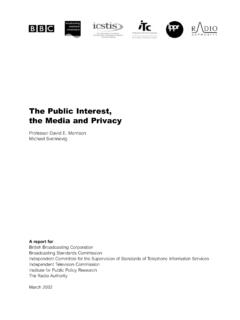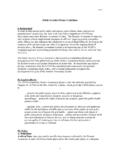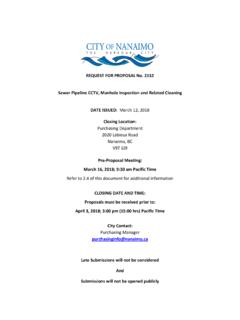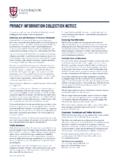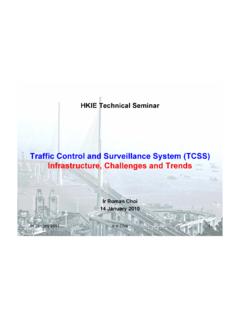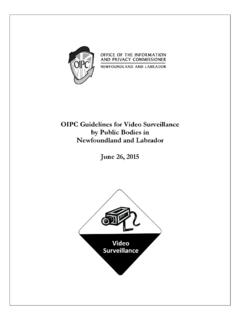Transcription of WHATS WRONG WITH ANPR - No CCTV
1 what S WRONG with ANPR'?A report by No cctv intoAutomatic Number Plate Recognition October community reduces crime, technology does notBIG DATA GRAPHIC On COVER FROMTHE Defense Advanced Research Projects Agency DARPA ()http commons wikimedia org wiki File DARPA Big Data jpg[://..//:__.]USED IN ACCORDANCE with DARPA USAGE GUIDELINESUSE OF THIS IMAGE IS IN NO WAY INTENDED TO SUGGEST THAT DARPA SUPPORT THE VIEWS CONTAINED IN THIS REPORTWHAT IS ANPR?NPR stands for Automatic Number Plate Recognition. ANPR cameras, as currently used in the UK, read the number plates of passing vehicles and in real time extract the characters and convert them into computer data so that they can be stored and compared with databases of vehicles and people, such as the Driver and Vehicle Licensing Agency (DVLA) database or the Police National Computer (PNC).
2 As well as storing the car number plate ANPR cameras may also store an image of the whole vehicle and driver. An North America ANPR is known as Automatic License Plate Recognition (ALPR).IPOLICE USE OF ANPR AS A MASS SURVEILLANCE TOOLNPR is a broad term that encompasses a variety of applications of number plate reading technology, which causes much confusion and misunderstanding. This report focuses on the police use of ANPR as a mass surveillance tool. This is a network of police ANPR cameras that are used alongside a variety of databases that can be used to identify cars and their occupants.
3 The data collected from the cameras is stored in local force databases (known as Back Office Facility or BOF) and in a centralised database the (National ANPR Data Centre or NADC). The data can then be used alongside data mining tools. The details of all vehicles passing police ANPR cameras are stored in these databases - the time, date, location and direction of travel of the vehicle and the image of the license plate are stored for two years and a photograph of the whole car and driver is stored for 90 report is not about ANPR cameras used by private companies, for example in car parks.
4 By the Highways Agency for average speed cameras or by local councils for congestion monitoring/charging or traffic enforcement ISSUESo better understand the concerns of civil liberties groups with regards to ANPR cameras it is useful to consider a time when there was no national ANPR network. In the 1980s a few privacy writers became aware of early tests of number plate recognition cameras by the police. Below are some extracts from what they CCTV1 what s WRONG with ANPR '?New Scientist 12th Jan 1984, Photo by Pete AddisCONCERNS FROM THE PRE ANPR PERSPECTIVEhe Home Office Scientific Development Branch (HOSDB) began development of ANPR in 19761.
5 Though early experiments were detailed in Her Majesty s Inspectorate of Constabulary (HMIC) reports of the early 1980s, several years passed before a trial caught the attention of journalists and privacy advocates. The reason given for ANPR was to screen motorway traffic for stolen vehicles but concerns were immediately raised about the dangers of such a HMIC report for the year of 19802 stated: T"Work on an automatic number plate reader project is progressing well and a model of the prototype is now being built on contract. Arrangements have been made with a police force for the equipment linked to the Police National Computer to be installed in an operational setting for a controlled experimental period.
6 "1984 NEW SCIENTISTn 1984 Journalist Steve Connor wrote an article for the New Scientist entitled 'Secret eye scans motorway'3, he wrote:I Police scientists have set up a secret experiment on a bridge spanning Britain's M1 motorway. Video cameras placed in a small cabin on the bridge record the registration of all vehicles passing along the motorway. They pass this information down a cable to a hut 100 metres from the bridge and tucked out of sight of motorway drivers. The hut contains a powerful minicomputer that checks each registration number against a list of vehicle numbers supplied from the Police National computer (PNC).
7 [..] A spokeswoman said: At the moment there is no intention of using it for anything other than detecting stolen cars. But, she added, this is flexible. As she put it: When the Russians take over next week things might change. [..] The equipment is probably the most advanced of its kind in civilian hands and has been developed by the Home Office's Scientific Research and Development Branch. [..] The Home Office says it has not finalised plans for the equipment, should the experiment prove successful. If it is, then Britain's motorists can look forward to a network of cameras monitoring all the major routes around London.
8 NO CCTV2 what s WRONG with ANPR '?1984 'POLICE COMPUTERS AND THE METROPOLITAN POLICE' REPORTn a report for the Greater London Council Police Committee entitled 'Police computers and the metropolitan police' (adopted by the Greater London Council on 17th July 1984) Dr Chris Pounder wrote4:I Random vehicle checking reflects a change in philosophy. Before the technology was available, checks were carried out when a police officer was suspicious. Now, no grounds for suspicion are necessary in the vast majority of cases, and checks are carried out at the whim of individual officers, in case anything has been recorded.
9 Thus without an announcement, explanation or debate in Parliament, the police have set up, through the PNC's vehicle indexes, the essentials of a country wide intelligence system that can monitor the movement of vehicles of 'interest' to checking is soon to be completely automated. Between July and October 1982, trials took place on the approaches to the London's Dartford Tunnel of a device which would automatically read car number plates and check them against the list of wanted vehicles obtained from the PNC. This has been superceded by a prototype device on the M1, which takes 15 seconds to check a car against a list of vehicles held.
10 The Home Office are working on the electronic circuitry necessary to reduce that time to under one second. The ease with which this device processes information makes every car a potential 'suspected' vehicle to be checked against police records without any grounds of suspicion to justify the check. Every vehicle becomes 'of interest' until the computer says that it is 'not of interest' to the police. Many police forces have expressed interest in this apparatus, which in production will cost approximately 10,000, well within the multi-million pound budgets of most police forces.

